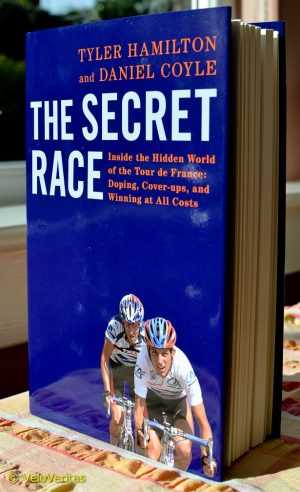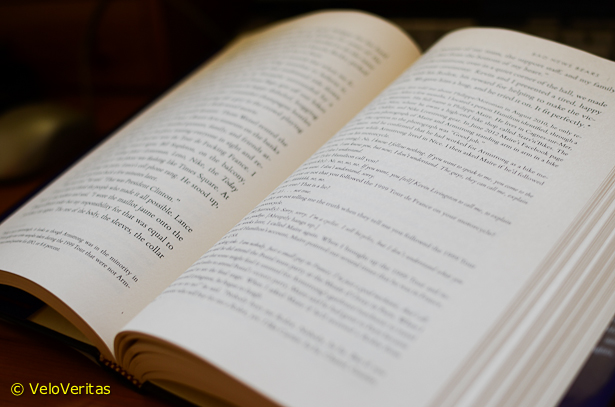
What are the Differences Between the US and UK versions of The Secret Race?
Putting to the side for a minute the fact that Tyler lied for years about his PED use before finally coming clean and whether that means everything he says can or can’t be trusted, and just reading this book with an open mind, it quickly becomes clear just how much an everyday part of pro cycling in the 1980’s, 90’s, and 2000’s PED and illegal blood manipulation actually was.
Of course, anyone with an interest in the sport already had more than an inkling that such cheating had always played a part, and fans of the sport have had to contend with scandal following scandal since forever, and particularly since the Festina affair in 1998.
Given that much – if not most – of what’s in this book is information that Tyler told the Federal Grand Jury (and the Federal Agents in later conference) in his sworn testimony, and the sheer detail in which situations are explained, it’s an utterly believable and pretty grim story and should leave no-one in any doubt about what went on during that era.
There are many points in The Secret Race that must leave even the most clued-up of cycling fans aghast, and saddened too. This is summed up for me when Tyler talks about his relationship with his trainer Luigi Cecchini, who – unusually for this period – encouraged Tyler to dope as little as possible; Cecco (as Tyler called him) felt that the qualities needed to do well were 1) be very, very fit, 2) be very, very skinny, and 3) keep your hematocrit up, which was something he recognised as a regrettable necessity.
Despite the content, the book is a fairly easy read. Coyle has strived to keep Tyler’s tone and uses words and vocabulary that are authentic, the tales and anecdotes flow quickly one after the other, which drive home the point that doping was regarded as normal, something everyone did. Tyler even got to the point where he could guess when other riders had dontated or been transfused a ‘BB’ (blood bag) judging by how they were riding, their targets and the time of year.
Several folk have been asking us whether the UK version of the book is worth buying since it has been altered to accomodate the stricter libel laws in the country.
So here are the differences between the two versions.
Suffice to say that the UK publication is not significantly different and readers won’t be missing out on any of the important details.

The Differences Between the US and UK versions of ‘The Secret Race’
There are ten main changes in the UK version of the book, with all except one almost inconsequential to the reader and involving only slight alterations to names or the rewording or addition of a statement or two.
The main redaction in the UK version concerns the footnotes on page 99 of the US version which carry more details about Armstrong’s ex-gardener, Philippe Maire, nicknamed ‘Motoman’, who followed the Tour around France in 1999 on a motorbike in order to deliver the drugs to the USPS camper van as required.
- p52. In the UK version Scott Mercier and Darren Baker’s names are removed when Tyler talks about being curious as to what George Hincapie and Johnny Weltz were discussing in Spanish, and when they found ampoules labeled EPO in a packet belonging to George in the fridge.
- p99. The UK version carries none of the footnotes which take up most of the page in the US version and which detail Philippe Maire’s home town and bike shop, as well as transcript extracts of several phone calls between Daniel Coyle and Maire.
- p111. Kevin Livingston’s name is removed from the UK version where Tyler says he and Lance talked openly about Ferrari and EPO in front of their partners.
- p133. Lance’s name is removed from the UK version where the Postal team’s eloquent handling of the Actovegin scandal is detailed.
- p141. The US version has a footnote about Jesús Manzano’s claims that Postal doctor Luis del Moral received advance warnings about anti-doping tester visits from Walter Viru, the former Kelme team doctor who ran the UCI-accredited Spanish hematology laboratory.
- p148. The footnote in the US version explains that when Armstrong had told Tyler that he had “been popped for EPO” at the 2001 Tour de Suisse, a source within the FBI said that a UCI official intervened in the process, and arranged for Armstrong and Bruyneel to meet Dr. Martial Saugy, the Director of the Lausanne laboratory responsible for terming the original sample “suspicious”.
- p234. The UK version contains the phrase “though Contador has always denied this” when Tyler mentions that Alberto was rumoured to be the Fuentes’ client with a code-name of ‘A.C.’
- p238. The footnote in the US version contains a reference to the Gazzetta Dello Sport article which talks of investigators uncovering a $465,000 payment from Armstrong to Ferrari made in 2006, two years after Armstrong publicly cut ties with the doctor.
- p268. The US version says that US Attorney André Birotte Jr. closed the investigation without consulting anyone, where the UK version says that he didn’t consult the prosecutor or the lead investigator.
- p274. In the US version only, when Tyler discusses Lance’s strategy in the USADA case, he states that USADA officials told ABC News that they believed Armstrong had hired private investigators to follow them.



